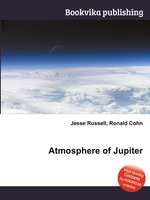Atmosphere of Jupiter
Jesse Russell Ronald Cohn
бумажная книга
High Quality Content by WIKIPEDIA articles! The atmosphere of Jupiter is the largest planetary atmosphere in the Solar System. It is mostly made of molecular hydrogen and helium in roughly solar proportions; other chemical compounds are present only in small amounts and include methane, ammonia, hydrogen sulfide and water. Although water is thought to reside deep in the atmosphere, its directly measured concentration is very low. The oxygen, nitrogen, sulfur, and noble gas abundances in Jupiter`s atmosphere exceed solar values by a factor of about three. The atmosphere of Jupiter lacks a clear lower boundary and gradually transitions into the fluid interior of the planet. From lowest to highest, the atmospheric layers are the troposphere, stratosphere, thermosphere and exosphere. Each layer has characteristic temperature gradients. The lowest layer, the troposphere, has a complicated system of clouds and hazes, comprising layers of ammonia, ammonium hydrosulfide and water. The upper ammonia clouds visible at Jupiter`s surface are organized in a dozen zonal bands parallel to the equator and are bounded by powerful zonal atmospheric flows (winds) known as jets. The bands alternate in color: the dark bands are called belts, while light ones are called zones. Zones, which are colder than belts, correspond to upwellings, while belts mark descending air. The zones` lighter color is believed to result from ammonia ice; what gives the belts their darker colors is not known with certainty. The origins of the banded structure and jets are not well understood, though two models exist. The shallow model holds that they are surface phenomena overlaying a stable interior. In the deep model, the bands and jets are just surface manifestations of deep circulation in Jupiter`s mantle of molecular hydrogen, which is organized in a number of cylinders.


